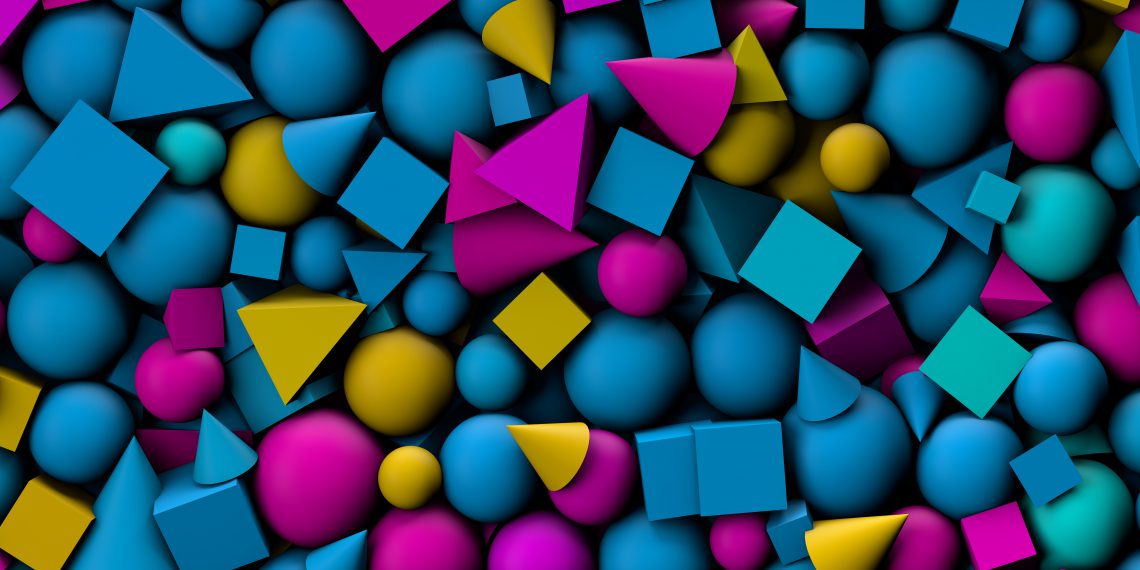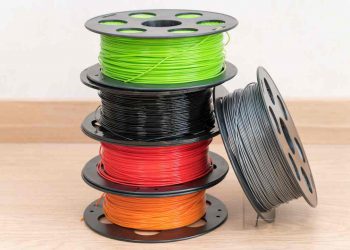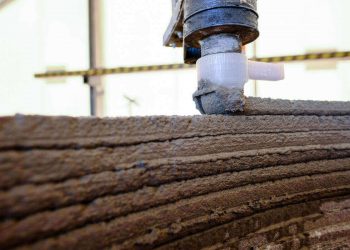As the 3D printer userbase has grown, so has the number of exciting new exotic filaments and resins, other than plastic made for 3D printers. Even though most such materials contain plastic to a large percentage, the blending of other materials with the plastic base is still apt enough that the resulting composites unmistakeably look and act the part of the blended material. A base of plastic polymer is necessary to make sure the materials can be 3D printed on existing consumer printers.
Today, we will take a look at 10 such composite materials available for consumer-grade 3D printers (FDM and/or SLA). Let’s dive in!
1) Wax
Wax 3D printing materials have been available for some time. And while professional-grade wax 3D printing is ideally done on a material jetting 3D printer, the growing number of wax or wax-like filaments, as well as wax resins has made it possible for users of consumer 3D printers to print using this incredibly moldable material.
In fact, the primary use-case for 3D printing with wax is to create lost wax metal castings. A casting technique used largely to make jewelleries, wedding bands, or casted metal parts. Almost all wax composite filaments or resins are engineered with this in mind. So, if you are someone whose work involves custom castings, then wax 3D printing filaments may save you a good deal of time on a particularly complicated casting.
2) Woodfill
Woodfill itself is a broad term to refer to normal 3D printing filament infused with wood shavings or pulverized wood. Commonly, PLA mixed with wood, bamboo, cork or even other more exotic plant-based materials is available for consumer FDM 3D printers.
Woodfill composite materials are largely aesthetic in nature, with blends ranging from 70% PLA 30% wood fibers, to 60% PLA 40% wood fibers. With the more premium filaments, the 3D print usually would not only feel and look like wood, but also have that aromatic woody smell based on the type of woodfill chosen. And since these materials are largely plastic, they can be sanded or otherwise post-processed in the same way as normal PLA parts.
3) Carbon fiber
Carbon fiber, like woodfill, is available as a carbon fiber plastic composite with varying degrees, 15% to 20% by weight in most cases, of carbon fiber strands blended in with the base plastic. Carbon fiber infused filaments are known for their outstanding rigidity as well as increased tensile strength. While in no way as strong as pure industrial-grade carbon fiber, the 3D printable composites can still be put to good use where increased rigidity and strength are a must from 3D prints.
Carbon fiber filaments are available in a large number of base polymers, such as PLA, ABS, Nylon and PETG. It should be noted that carbon fiber filaments are abrasive and would easily wear down a brass extrusion nozzle. These filaments are best used with hardened steel nozzles.
4) Clay
Clay infused filaments provide an earthy look and feel. These special filaments are achieved by blending stone powders directly into a PLA base. Normally the ratio is kept between 30:70 to 50:50 by weight. However, specialty filaments with higher or lower percentages pop up all the time. The advantages of a clay filament include easy post-processing. Similar to how one would deal with a clay model by simple wet sanding. As these filaments contain stone powders, it is best to use an abrasion resistant nozzle like a hardened steel nozzle.
These clay 3D prints can also optionally be put in a blast furnace to “cook” the clay prints, similar to clay pots, achieving a similar glaze finish.
5) Sandstone
Sandstone filaments are available in a variety of colours that mimic various forms of naturally occurring sandstones. These are also infused filaments similar to clay. But where clay filaments provide a smooth earthy look and texture, sandstone filaments are best known for their coarse, stony finish. The 3D prints themselves can be easily post-processed via sanding to increase (or decrease) the coarseness, thereby ensuring the stone aesthetic.
A hardened steel nozzle is a must as sandstone filaments, though not as abrasive as carbon fiber filaments, still tend to be quite abrasive just the same.
6) Metalfill
Metalfill filaments often come with a very high percentage (up to 80% or more) of metal powder mixed with a plastic base, mostly PLA. The result is a 3D printable material that for all intents and purposes, looks, feels and acts like a metal part.
As with any composite filament, the higher the percentage of the added non-plastic material, the more brittle the resultant filament. Also, like carbon fiber, a wear resistant nozzle such as a hardened steel nozzle is recommended. Metal filled filaments also tend to behave differently than pure plastic with 3D printed features such as overhangs and bridges.
If you can put up with the relatively increased learning curve to use a metal filament however, then a world of 3D printed metal models awaits. These metal filled 3D prints can be readily polished and processed to further increase the metal look and feel. Metalfill filaments are available in bronze, brass, copper, magnetic iron and other metal powder composites.
In addition to the metallic look and heavier feel, these composites have the added benefit of metallic properties, such as electrical conductivity (highest with copperfill), and magnetic or rustible parts (with magnetic ironfill). 3D prints with high percentage metalfill filaments can also optionally be blasted in a furnace to achieve a 100% metal print.
7) Aluminum
Aluminum filaments are in large part comparable to other metalfill filaments including the percentage mix with the plastic base. Where they differ, however, is that where other metalfill filaments are geared more towards aesthetics and feel, aluminum filaments are largely geared towards practically useable 3D printed aluminum parts.
Aluminum filaments are also designed with furnace sintering in mind. The 3D printed parts can often readily be blasted inside a furnace or kiln to melt away the plastic to achieve a useable 100% aluminum part. Again, the base is most commonly PLA.
8) Ceramics
Ceramic infused filaments and resins are known for their high rigidity as well as aesthetic value. Ceramic materials are available both for FDM/FFF, as well as SLA/DLP/LCD type consumer 3D printers. In both cases, fine ceramic powder is mixed in with the base plastic and the resultant print can be finished just like any other ceramic part.
Regardless of the type of 3D printer used, nearly all ceramic 3D prints can be cooked inside a kiln to achieve a pure ceramic part. Thereby serving both aesthetic, as well as practical use cases.
9) Glass and glass fiber
While not as strong as carbon fiber, glass fiber has the advantage of providing varied aesthetics since the colour as well as aesthetic can largely be modified by altering the base plastic. Glass fiber adds significant structural rigidity as well as strength. Additionally, glass fiber material is available both for extrusion-type 3D printers, as well as resin 3D printers.
Glass powder infused liquid resins are available for consumer grade resin 3D printers that can produce a glass-polymer 3D print, which once cooked inside a kiln, would leave a pure glass object.
10) Biofills
So, uptil now, we have went through woodfill, metalfill as well as ceramicfills. What next you ask? Biofills of course!
Biofills are a niche category of filament for extrusion printers where biowaste is infused with plastic (typically PLA), to achieve a unique aesthetic as well as aromatic tone during the 3D printing process.
Biofill filaments are generally available with coffee, beer and even hempfill.
Hemp filament on the other hand is not made from a waste byproduct. It is instead infused with actual hemp. This filament also provides increased strength while being lightweight in finished prints.
11) Bonus round: Pancake batter (and purees)
While pancake batter does not provide a very large number of structural advantages, apart from being delicious, it does highlight how far consumer 3D printing technology has come.
Aside from the $300 pancake bot that cooks as well as 3D prints pancakes, aftermarket as well as opensource mods are available for the vast majority of consumer 3D printers, that give them food printing capabilities. Including practically all RepRap based 3D printers.
Nearly all ingredients that can be pureed to a paste like consistency are fair game for food 3D printing. So, while still being a novelty at this stage, 3D printing food modelled and detailed in a CAD software does open up some intriguing possibilities for the creatively minded.
The wonders of 3D printing are immense and diverse. The sheer joy of having a computerized gadget construct a 3D design of one’s own choosing is arguably incomparable to any other technological breakthrough of our time. Add in the potential of printing in not only plastic, but a plethora of other exotic materials, and it becomes easy to see why 3D printers, despite being as old a technology as they are – still can make grown individuals giddy with excitement.






